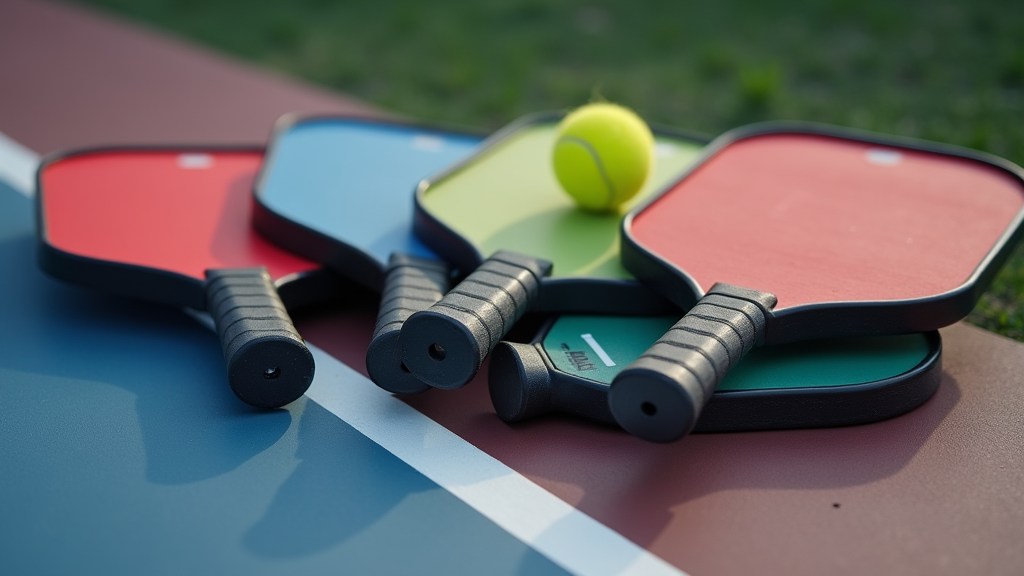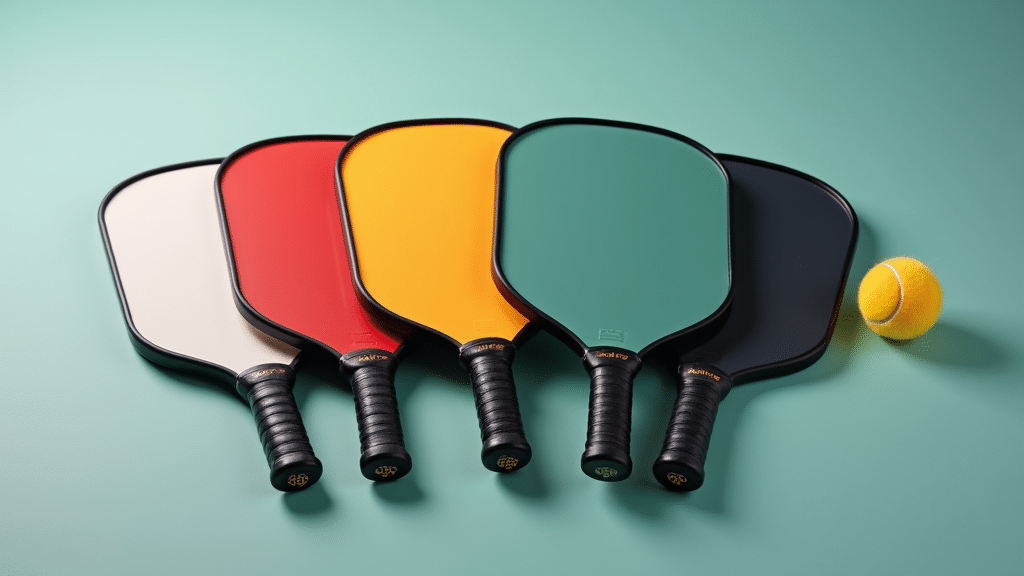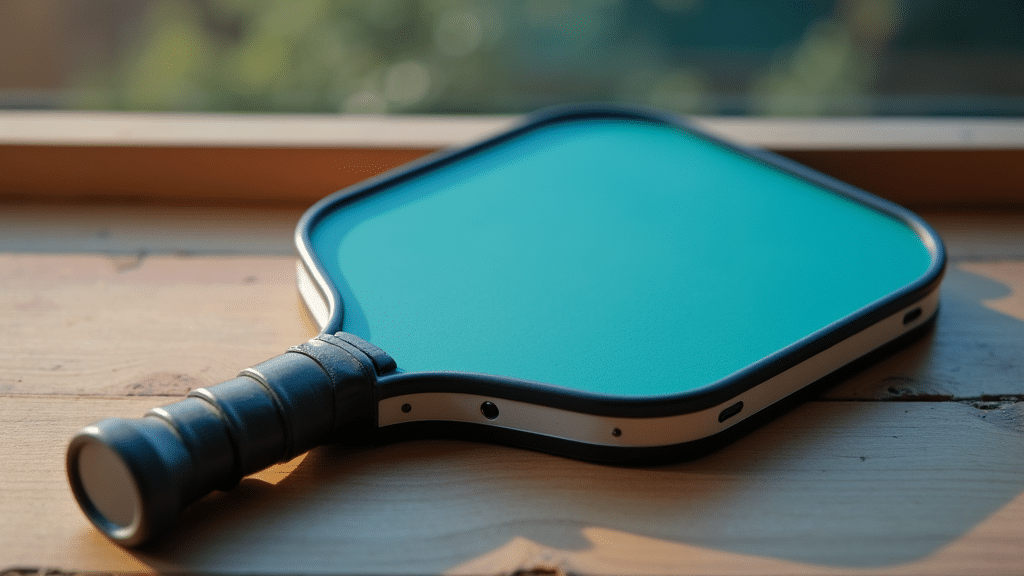Table of Contents
Introduction

Overview and Importance
Choosing the right grip size is absolutely crucial for maximizing your pickleball performance. It’s not just about comfort; it’s about enhancing your control, minimizing fatigue, and significantly reducing your risk of injury. Think of your paddle as an extension of your arm – the correct grip size ensures that this extension is effective, comfortable, and responsive.
Did you know that using an incorrect grip size can lead to a 20% decrease in your control over the ball? Or that selecting the proper grip size can reduce your risk of developing tennis elbow by as much as 30%? These aren’t just arbitrary numbers; they represent real improvements in your game and well-being. Playing with the right grip size allows for more precise shots, quicker reactions, and a more confident overall game.
Ultimately, selecting the correct grip size dramatically improves your overall playing experience. You’ll be able to play longer, with less fatigue, and with a greater sense of connection to your paddle. This translates to more enjoyable matches, improved skill development, and a reduced likelihood of nagging injuries that can keep you off the court.
Background
The importance of grip size wasn’t always widely recognized in the early days of pickleball. Back then, paddles often came with limited grip size options, forcing players to adapt as best they could. Many players resorted to modifying their grips, using tape or other materials to build up the size and achieve a better fit. This DIY approach highlighted the inherent need for personalized grip solutions, even if the industry hadn’t fully caught up yet.
Thankfully, we’ve seen significant advancements in recent years. Today, there’s a much wider availability of grip sizes, catering to a broader range of hand sizes and preferences. Furthermore, manufacturers are constantly innovating with new grip materials designed for enhanced comfort, improved moisture absorption, and superior performance. You’ll often find paddles clearly marked with grip size stickers, making the selection process more straightforward.
What You’ll Learn
In the following sections, we’ll delve into the core concepts surrounding pickleball grip sizes. You’ll learn exactly how grip size affects your performance on the court, impacting everything from your shot power to your wrist mobility. We’ll also guide you through practical methods for accurately measuring your ideal grip size, ensuring you have the information you need to make the right choice.
Beyond the theory, we’ll provide practical applications you can use immediately. You’ll discover how to select the right grip size when purchasing a new paddle, and how to adjust the grip size of your existing paddle using readily available accessories like overgrips and tape. By the end of this guide, you’ll be equipped with the knowledge and skills to optimize your grip and elevate your pickleball game.
Understanding the Basics of Pickleball Grip Size
Fundamental Concepts
Choosing the right grip size for your pickleball paddle is crucial for comfort, performance, and injury prevention. It’s a foundational element that directly impacts your control, power, and overall enjoyment of the game. Let’s delve into the fundamental concepts.
Understanding the key definitions is the first step:
- Grip Size:This refers to the circumference of the paddle handle. It’s typically measured in inches and dictates how the paddle feels in your hand.
- Overgrip:An overgrip is a tape-like material that’s applied over the existing grip. Players often use overgrips to increase the grip size, enhance comfort, and absorb moisture.
Beyond definitions, grasping the core principles is equally important:
- The ideal grip size should allow you to comfortably wrap your fingers around the handle without excessive strain or overlap. It should feel natural and secure in your hand.
- Selecting the correct grip size isn’t just about comfort; it’s about preventing injuries. A grip that’s too small can lead to excessive muscle strain, while a grip that’s too large can limit your wrist mobility and control. The right grip enhances your movement and allows for optimal performance.
Essential Components
Now that we’ve covered the fundamental concepts, let’s examine the essential components involved in determining your ideal pickleball grip size.
You’ll need a few required elements to get started:
- Pickleball Paddle:This is the foundation of the process. You’ll be measuring its grip to determine the appropriate size.
- Measuring Tape or Ruler:A flexible measuring tape is ideal, but a ruler can also work. Accuracy is key for a precise measurement.
- Overgrip (optional):While optional for the initial measurement, an overgrip is essential for fine-tuning the grip size and customizing the feel of your paddle.
When considering grip size, there are key features to keep in mind:
Primary aspects:
- Grip Circumference (measured in inches):This is the most critical factor. The circumference determines how the grip fits in your hand.
- Grip Material (synthetic leather, foam, etc.):The material affects the feel, comfort, and absorbency of the grip.
Secondary aspects:
- Grip Texture (smooth, ribbed, perforated):Texture influences grip and moisture management. Some players prefer a smooth feel, while others prefer the added grip of a ribbed or perforated surface.
- Grip Shape (round, octagonal):The shape can affect how the paddle sits in your hand and your ability to generate spin.
Important variations in grip sizes exist to accommodate different hand sizes:
- Small grip:Typically less than 4 inches in circumference.
- Medium grip:Generally ranges from 4 to 4.5 inches.
- Large grip:Usually 4 5/8 inches and larger.
Detailed Guide

Preparation
Before diving into the process of determining your ideal pickleball grip size, proper preparation is key. Gathering the right materials and setting up your workspace will ensure accurate and reliable measurements.
- Required materials:
- Soft measuring tape: Essential for accurate circumference measurements.
- Ruler: Useful for measuring the length from the base of your palm to the tip of your ring finger.
- Pickleball paddle: To test the feel of different grip sizes.
- Pen and paper: For recording your measurements and observations.
With these tools at hand, you’ll be well-equipped to find the perfect grip size for your pickleball paddle.
- Initial setup:
- Ensure you have adequate lighting: Good visibility is crucial for accurate measurements.
- Prepare a flat surface for measuring: A stable surface will help keep your measurements consistent.
A well-lit and organized workspace will streamline the measuring process and minimize errors.
- Important considerations:
- Measure your hand circumference or distance from the tip of the middle finger to the line in the middle of the palm: These are primary indicators of appropriate grip size.
- Consider hand thickness and finger length: These factors influence how comfortably you can hold and control the paddle.
- Note potential use of an overgrip, which adds 1/16 to 1/8 inch to the grip size: Account for this additional thickness when making your measurements.
Taking these considerations into account from the outset will help you fine-tune your grip selection and optimize your performance on the court.
Step-by-Step Process
Measuring your hand for the ideal pickleball grip size doesn’t have to be complicated. Follow these clear, step-by-step instructions to get accurate measurements and improve your game.
- Clear instructions:
- Use a soft tape measure: This ensures flexibility and accurate contouring around your hand.
- Straighten fingers and turn your palm up: This provides a consistent hand position for measurement.
- Identify the palm’s three main folds: These folds serve as reference points for accurate measurement.
- Measure from the crease at the base of the palm to the tip of your ring finger; usually between 4 and 5 inches: This length helps determine the appropriate grip length.
- Measure the circumference of your hand at its widest point, typically across the knuckles: This measurement is crucial for determining the grip size.
By following these steps carefully, you’ll obtain the necessary measurements to choose a grip size that enhances your comfort and control.
- Best practices:
- Measure multiple times to ensure accuracy: Taking several measurements helps minimize errors and ensures consistency.
- Use both the ruler method and the finger test: Combining methods provides a more comprehensive assessment.
- Consider your playing style and hand strength: These factors can influence your grip preference.
Adhering to these best practices will increase the reliability of your measurements and guide you toward the optimal grip size for your individual needs.
- Common mistakes to avoid:
- Measuring with fingers bent: This can distort the measurements and lead to inaccurate results.
- Ignoring hand thickness: Hand thickness affects how the grip feels in your hand.
- Choosing a grip size solely based on height: Height is not a reliable indicator of hand size.
Avoiding these common pitfalls will help you achieve more accurate measurements and make an informed decision about your grip size.
Advanced Techniques
For players looking to fine-tune their grip even further, advanced techniques can provide a competitive edge. These expert tips, optimization methods, and troubleshooting strategies will help you customize your grip for peak performance.
- Expert tips:
- If between sizes, opt for the smaller grip and use an overgrip to adjust: It’s easier to increase grip size than to decrease it.
- Test different grips by holding paddles with varying sizes: Hands-on testing is invaluable for determining the best fit.
- Consider handle shape and type of grip: Different handle shapes and grip materials can affect comfort and control.
These expert tips will help you make subtle adjustments to your grip, maximizing comfort and enhancing your game.
- Optimization methods:
- Use foam tape to increase grip size significantly: Foam tape offers a substantial increase in grip size for players with larger hands.
- Experiment with different overgrip materials for comfort and sweat absorption: Different materials provide varying levels of comfort and moisture control.
- Customize grip shape by adding ridges or contours: Tailoring the grip shape can improve hand contact and control.
By employing these optimization methods, you can create a truly personalized grip that enhances your performance and reduces fatigue.
- Troubleshooting:
- If the grip feels too small, add an overgrip or foam tape: These additions will increase the grip size and improve comfort.
- If the grip feels too large, consider a thinner replacement grip: A thinner grip will provide a more secure hold for players with smaller hands.
- If experiencing hand fatigue, adjust grip size and tension: Proper grip size and tension can alleviate hand fatigue and improve endurance.
Addressing these common issues with targeted solutions will ensure that your grip remains comfortable and effective, allowing you to play your best game.



